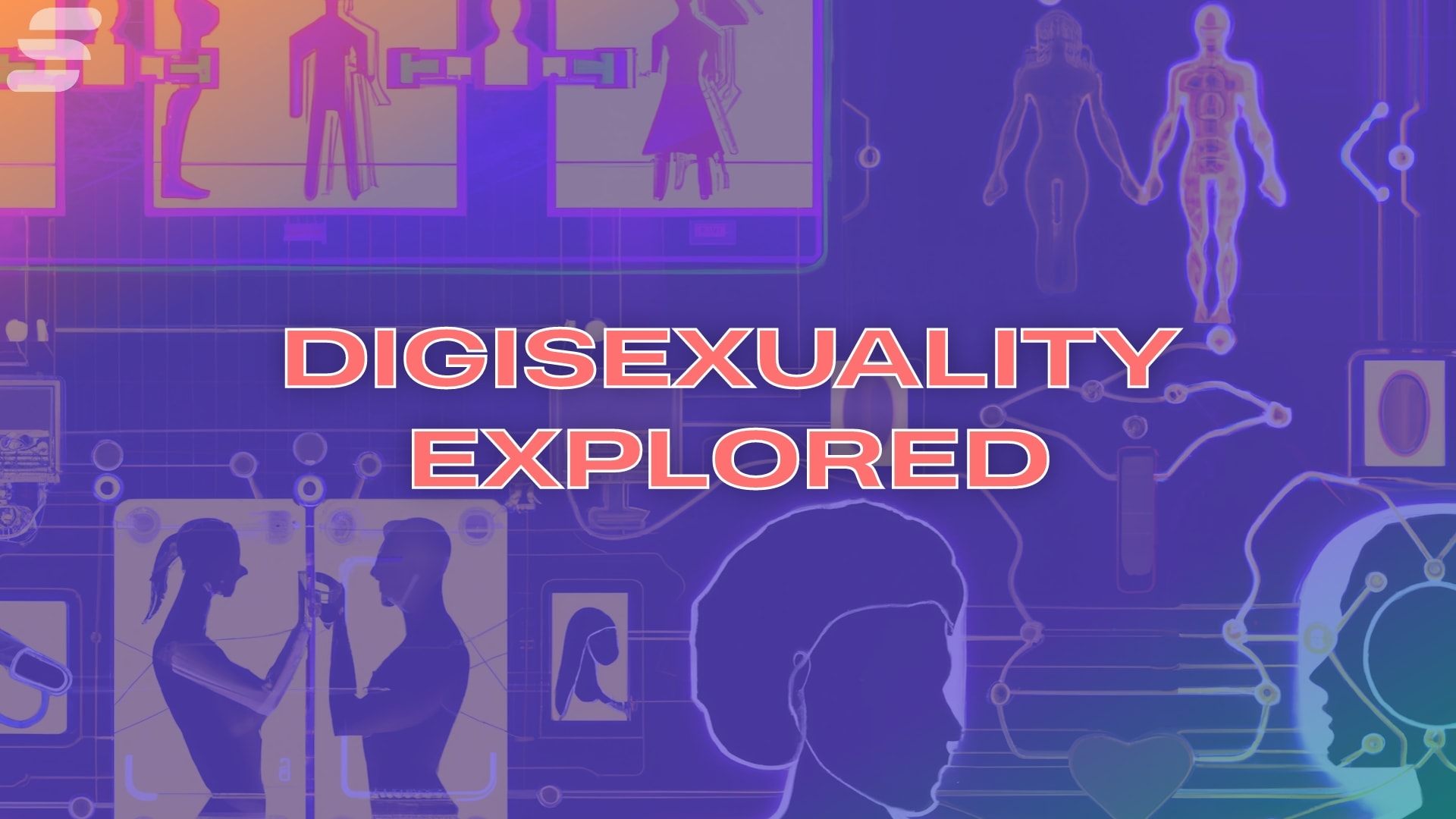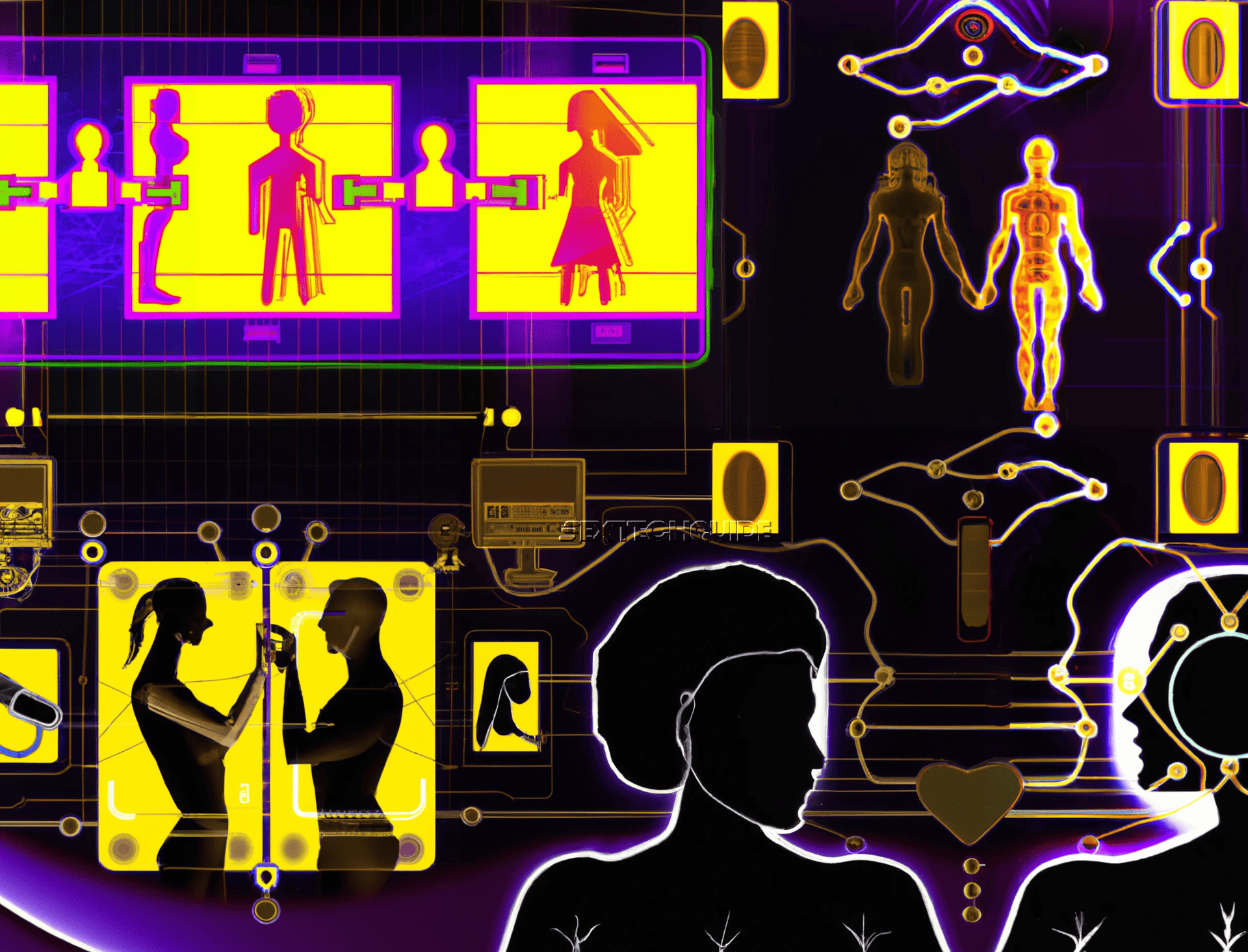Digisexuality: The future of intimacy in a technological world

Despite the fact that you might not have heard the term ‘digisexual’ we might all fall inside its spectrum. The term, developed in 2017 by North American academics Neil McArthur and Markie Twist, is used to describe someone whose “primary sexual identity comes through the use of technology”.
But what does this really mean and what are its implications?
On one end of the spectrum, we find individuals who identify as digisexuals and exclusively engage in sexual activities with digital entities, eliminating human contact. At the other end, many argue that considering the pervasiveness of technology in our current lives, we all exhibit elements of digisexuality to some extent. These people would consider anyone who has ever done anything like sending a sext, using a smart vibrator, or watching VR porn as part of the digisexual ‘club’.
No matter where you find yourself on this spectrum, it’s undeniably an intriguing idea that will certainly shape our future interactions with technology. Check out this comedy sketch of a mom trying to be supportive of her daughter’s AI boyfriend for a tongue-in-cheek reminder of how quickly our world is evolving.

Digisexuality and technology
Technology is increasingly integrated into our daily lives, including our sexual experiences. From basic vibrators to advanced AI-based sex dolls like Microsoft’s Xiaoice chatbot or Emma, a humanoid animatronic sex doll, a variety of options are available. AI girlfriends such as CarynAI and EvaAI have been recently introduced too.
For those who grew up in a technologically advanced world, using devices and apps to facilitate human-to-human interaction may seem normal. These include sexting, hookups via dating apps like Tinder and Bumble, long-distance Zoom chats, and flirting through direct messages on Instagram.
Circumvent Big Tech's Censorship! Never miss another post!
Subscribe to our notifications!
Article continues below
Predominantly, there are two waves of digisexuality:
Tech-facilitated digisexuality
The first waveTechnology that facilitates a connection between human partners—such as live sex chat sites, sex toys that let users ‘feel’ one another electronically from brands like Kiiroo and Lovense, and even online dating services—marks the first one.
Long-distance relationships have benefited from teledildonics, which allow two people to engage with each other sexually using tactile and remote-controlled toys.
Sexting is the combination of texting and having sex. Sending sexual text messages is known as sexting. Additionally, sending explicit videos and nude or semi-naked photos of yourself is common. Sexting can occur through direct messaging on social media sites, messaging on mobile devices, and other messaging services.
It’s connected to digisexuality because the communication between the two parties is done via technology, and can actually be a help in various cases. An example is people who are involved in long-distance relationships, or for the LGBTQ+ community to find romantic partners.
With Tinder, you can meet locals worldwide and maximize your dating opportunities. Online you can be who you want to be and meet the people you want, regardless of your location or your sexual orientation. This also relates to technology bridging the restrictive gaps between people, for example where social systems such as heteronormativity have restricted them and allowed them to explore romantic options more freely.
This is especially true for same-sex couples whereby a study found that since the start of online dating, the percentage of LGBTQ+ people who meet online has consistently been much higher than heterosexual couples.
Tech-immersive digisexuality
The second waveImmersion is characteristic of the second wave of digisexuality, which is currently in development. With these innovations, a human companion is not necessarily required for a sexual encounter. Sex robots and virtual reality devices are examples of this second wave of digisexuality.
As a result of the “sense of presence” VR offers it is very much different from other digital experiences. VR technology causes the illusion of location and believability, in the human brain. The 3D display, the entire field of view, and real-time positioning give the user’s brain the impression that they are physically present.
Research shows that the brain doesn’t really make much of a distinction between being aroused by pornographic media and having sex with a real person. If we take it a step further and engage with immersive VR adult entertainment, our brain appears to be even less able to discern between various scenarios.
With time, technology will probably only become more ingrained in our romantic relationships, and for the majority of people, it will probably serve only as an enhancement or accessory to time-honored customs. Even if you’ve never heard the phrase “digisexual,” chances are you’ve seen some variation, most likely in a science fiction film.
In the 2013 film Her, a lonely guy fell in love with an AI, and in the film Blade Runner 2049 from 2017, the protagonist and an AI were also in a digital romance. Even Black Mirror’s use of romance and technology depicts this. This can be seen in Be Right Back (Season 2, Episode 1). A mourning woman “contacts” her late lover after learning about a new AI service that enables users to communicate with the recently deceased.
Although the represented digisexual relationships may start out tentative and shallow, they eventually develop into deeply satisfying and erotic encounters that raise interesting questions about what intimacy is or can be. Another example is the sex scene between Joaquin Phoenix and Scarlett Johansen’s characters. Johansson’s only option as a disembodied AI voice was to express the imagined closeness and erotic feelings she was experiencing with Phoenix — even though for him it could basically be described as phone sex.
The impact of digisexuality
When it comes to the digisexual arena, particularly the realm of sex robots, users may be able to develop their sexual knowledge and skills without the intense pressure of interpersonal closeness with another human with other needs. Additionally, sex with robots or even smart sex toys may provide solace to people dealing with a variety of sexually-related issues, such as illness, dysfunction (e.g. erectile or anorgasmia), libido issues, loneliness, or for people with disabilities.
According to some research, using sex dolls and other digisexual tools such as teledidonics, sonic massagers, vibrators, and VR, may have similar beneficial effects to using pornography in terms of lowering sexual anxiety, overcoming sexual frustration, and disparity in sexual desire between partners. They may even be used therapeutically to deal with issues like interpersonal issues, sexual dysfunctions, sexual trauma, and sexual deprivation.
Digital media and technologies have already been shown to significantly alter sexual behavior. In this perspective, embodied technologies like sex dolls and sex robots shouldn’t be disregarded, especially given that the sexual usage of human-like material artifacts has long since gained popularity.
The use and normalization of sex toys, including ones that represent human body parts such as penis-shaped dildos, is widespread. Not to mention that in the United States and Germany, women and men who identify as heterosexual use vibrators 50% of the time on average. Therefore, it sex technology is well-integrated into our sex lives without much thought.
Psychological implications
Our psychological perceptions of intimacy and sexual performance could be altered by digisexuality. Consider it this way: when you experience a climax with a partner, orgasm releases oxytocin into the bloodstream, referred to as the “bonding” or “love” hormone, and a deeper connection can be formed.
By producing motivational and empathetic processes, VR has a huge potential to trigger emotions efficiently and naturally, making it an important site to research emotions. If graphics can elicit a similar emotion, then adult VR content could trigger desire and arousal, outside of a human relationship. Arguably, this may impact our ability to relate to each other.
American Sexologist Dr. Gloria Brame poses some concerns about our relationships with technology. “Digisex isn’t just our future, it’s here [now] in the form of adult dolls.” She goes on to add that she would love to see the psychological profiles of chronic adult-doll users to understand whether the overall quality of their inner lives has improved or deteriorated.
“Thus far, there is only anecdotal evidence,” says Brame,” and it suggests it may make psychological issues even worse. Some users become more anti-social, some develop obsessions with their dolls, and the most vulnerable users appear to get lost in fantasy lives.”
Speaking with Sex Therapist, Dr. Shannon Chavez who said that intimacy with technology has the ability to change our mode of communication “and the primal connection that we gain through eye contact, touch, and social interaction.” She adds that it’s changing the way we experience “connection and sex making it more challenging to explore and find valuable intimate connections.”
While there are obvious benefits, including helping people learn hands-on skills and practice sexual acts to overcome concerns and dysfunction, Chavez argues that “technology for sexual interaction relies more on fantasy than reality with a void around the skills of negotiation, consent, and compromise along with communication skills needed to navigate all the facets of intimacy.”
However, according to the author of Turned On: Science, Sex and Robots, Dr. Kate Devlin, says “A lot of people are concerned that there has to be a lot of sacredness or purity to sex, I can see how sex can be a really lovely thing between two or more people, but masturbations are also an everyday part of life.” She goes on to say that she is not concerned about machines coming in to replace humans because “technology can be used to facilitate and enhance relationships.”
Social implications
Digisexuality reinforces unrealistic beauty standards through the flawless appearance of VR or AI pornstars and sexbots that are modeled off of mainstream pornography adhering to white Eurocentric beauty standards. This could lead to a spouse being sexually insecure, and digisexuality may bring up triggering feelings, negatively impacting the fabric of monogamous relationships.
There is the controversial claim that the mainstream landscape of sexbots may reinforce patriarchal norms that women are objects to satisfy men’s sexual needs and that real women should always be available for sex as a result of them.
Nevertheless, digisexuals have arguably been stigmatized in society that doesn’t yet understand it. Whether digisexuality is an identity that makes sense or not, sexual technology is relatively new and many who have self-identified have faced stigma by existing outside of normative sexuality.
Neil McAuthur the coauthor of “The Rise of Digisexuality,” said “We shouldn’t create a new closet for digisexuals,” said McArthur. “If we’ve learned anything from our history of stigmatizing people with marginalized sexual identities, it’s that we always realize later that we shouldn’t have done that. So maybe we should just skip that right now, and just accept this as something that can be normal and healthy.”
Ethical considerations in digisexuality
Consent is in effect when everyone involved in any form of sexual act freely chooses to participate. Additionally, they must possess the freedom and capability to make that decision.
The abrupt introduction of sex toys during sex is one issue people may face when trying to involve them with their partners. Ultimately, to have fully informed consent, it’s best to communicate and negotiate whether technology is to be incorporated in the bedroom well in advance.
When looking at sex tech consent outside of the bedroom, sex tech also needs to follow the same regulations as other consumer goods. There is no one guarantee that sex toys are safe because the sector is not governed by watchdog organizations like the Food and Drug Administration (FDA) or Consumer Product Safety Commission.
People’s privacy should also be respected, so make sure that your sex tech is end-to-end encrypted. Sexting privacy best practices are the same as for other activities: the general rule of thumb is ideally don’t post anything online unless you’re okay with everyone seeing it.
Keep in mind that once you press the “send” key, you lose control over all of the content on the internet.
The main privacy concern for adults who sext is the possibility of being violated. Although interpersonal trust and intimacy are undoubtedly at stake, the focus is on the broader social norms and assumptions about privacy that underpin people’s expectations of their own privacy.

The future of digisexuality
Researchers predict that many people may eventually “come to use robots as their primary mode of sexual experience” because they are tailored to individuals’ desires and “will do things that human partners cannot or will not do.”
The growth that will occur with advancements in applied sciences or technology becoming more potent, accurate, efficient, or capable is immeasurable. Throughout history, significant changes have been brought about by scientific and technological developments, some of which are better than others. With digisexuality, the potential is limitless.
Even though it is uncertain where the future of digisexuality lies, it is crucial to take into account the creation of sexual identity for those who like their experiences to be electronically centered.
Digisexuality promises to open up a world of connection for the isolated, socially awkward, or experimental. Not everyone is adept at striking up a conversation with someone and developing a relationship — at least without practice. This will eventually cause cultural shifts that the world will simply have to adjust to.
When it comes to digisexuality, the potential for positive or negative outcomes abound. This is because digisexuality in itself is based on a lot of factors which include privacy, the users, the technology, bots, or “voices” that might be involved.
These outcomes can be preempted if law enforcement agencies worldwide start recognizing the potential of this identity, and get ahead of it before criminals do and damage is done.
Digisexuality is here to stay
Even though digisexuality may sound like a new idea or identity, it is becoming increasingly normalized as everyone has, in one way or another, engaged with it due to the omnipresence of technology in our everyday lives.
The psychological and social changes that are occurring as a result of this can be dutifully managed as humans easily adapt. Of course, there are ethics to consider, as with any new idea adopted by people en-masse. The future of digisexuality is something to look forward to, as technological advancements are growing speedily.
Whether we’re ready for them or not, digisexuality is here to stay. We shouldn’t be afraid of it. Instead, be open to experimenting and taking advantage of its benefits. People may miss out on activities they could truly enjoy because of their apprehension about sex and technology.
The emergence of digisexuality as a novel identity could potentially provide individuals with a broader platform to explore and genuinely express themselves. It would be smart for legislators and law enforcement agencies to anticipate this evolution, ensuring a safe and secure environment as this concept continues to permeate globally.






